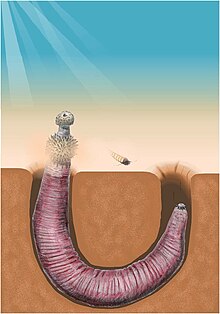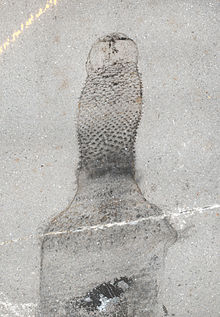Ottoia
|
Ottoia Temporal range: Cambrian Series 3–Furongian |
|
|---|---|
 |
|
| Reconstruction of Ottoia in a burrow. | |
 |
|
| The anterior portion of Ottoia, illustrating annulation and the eversible proboscis. From Smith et al. (2015) | |
| Scientific classification | |
| Kingdom: | Animalia |
| Stem group: | Priapulida (?) |
| Family: |
†Ottoiidae Walott, 1911 |
| Genus: |
†Ottoia Walcott, 1911 |
| Species | |
|
|
Ottoia is a stem-group archaeopriapulid worm known from Cambrian fossils. Although priapulid-like worms from various Cambrian deposits are often referred to Ottoia on spurious grounds, the only clear Ottoia macrofossils come from the Burgess Shale of British Columbia, which was deposited 508 million years ago. Microfossils extend the record of Ottoia throughout the Western Canada Sedimentary Basin, from the mid- to late- Cambrian.
Ottoia specimens are on average 8 centimeters in length. Both length and width show variation with contraction; shorter specimens often being wider than longer ones. The characteristic proboscis of priapulids is present at the anterior, attached to the trunk of the animal, proceeded by the "bursa" at the posterior. The organism's body is bilaterally symmetrical, however, its anterior displays external radial symmetry. Like some other modern invertebrates, a cuticle restricts the size of and protects the animal.
The trunk hosts the internal organs of the organism, divided into seventy to a hundred annulations of varying spacing, depending on curvature and contraction. The posterior displays a series of hooks, which likely acted as anchors during burrowing. Muscles support the animal and retract the bursa and proboscis. A gut leading from the anus in the bursa to the mouth in the proboscis runs through the trunk's spacious body cavity, and a concentration of gut muscles serve the function of a gizzard. A nerve chord runs down the organism's length. In addition to the other organs, it is possible Ottoia contained urogenital organs in its trunk. There is no evidence of a respiratory organ, though the bursa may have served this purpose.
The everted proboscis of Ottoia bears an armature of teeth and hooks. The detailed morphology of these elements distinguishes the two described species, O. tricuspida and O. prolifica. At the base of the pharynx, separated from the teeth by an unarmed region, sits a ring of spines. Behind this, at the front of the trunk, lies a series of hooks and spines, arranged in a quincunx pattern like the five dots on a domino or die.
...
Wikipedia
